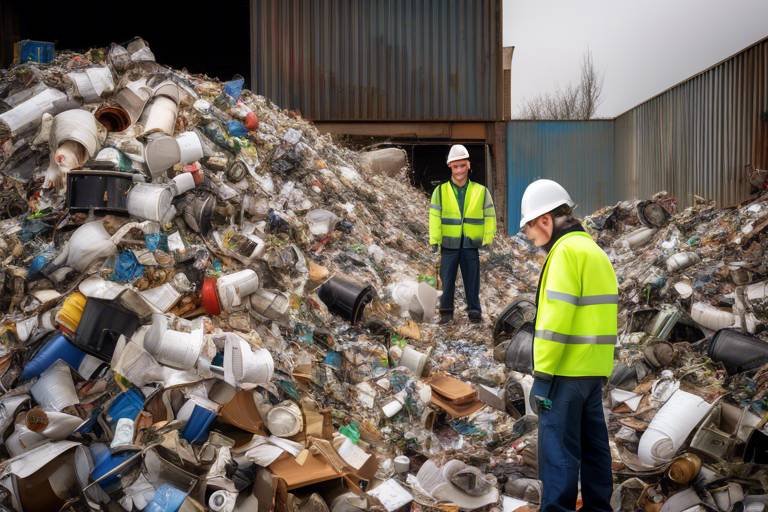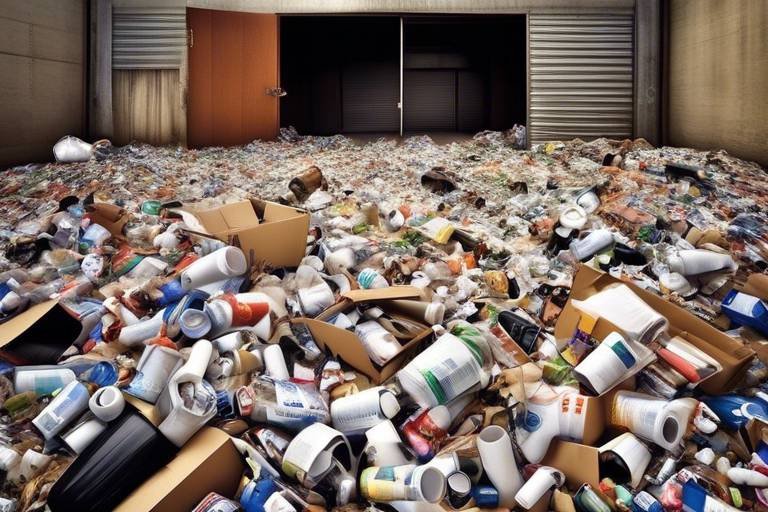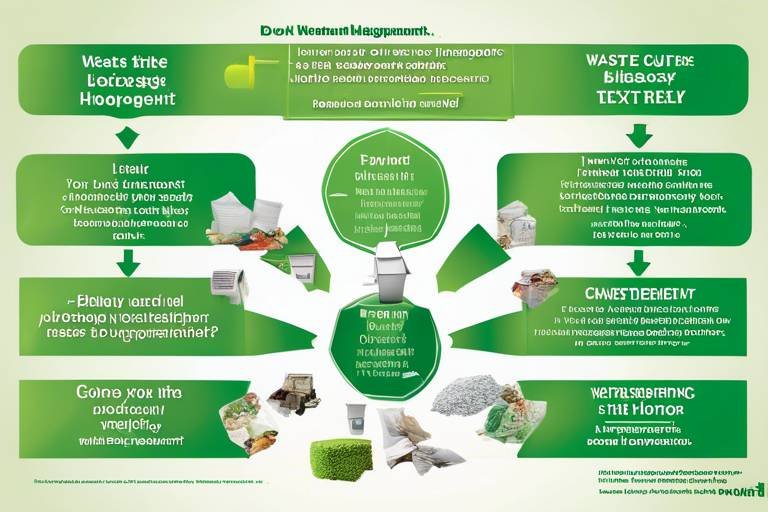The Impact of Air Pollution from Waste Management Practices
Air pollution is a pressing issue that affects us all, and one of its significant contributors is the way we manage our waste. When we think about waste management, we often picture landfills or recycling centers, but the reality is much more complex. Waste management practices can directly influence the quality of the air we breathe, leading to severe environmental and health consequences. In this article, we will delve into the various ways that waste management contributes to air pollution, exploring its sources, effects, and potential solutions for a more sustainable future.
Air pollution refers to the presence of harmful substances in the atmosphere, which can pose serious risks to human health and the environment. These substances can originate from various sources, including industrial emissions, vehicle exhaust, and, notably, waste management practices. When waste is improperly managed, it can release a range of pollutants into the air, including greenhouse gases and particulate matter. As we explore the connections between waste management and air pollution, it's essential to recognize that every discarded item has the potential to impact our air quality.
There are several waste management practices that are commonly employed, such as landfilling, incineration, and recycling. Each of these methods has its own environmental footprint, particularly concerning air quality. For instance, while recycling is often viewed as a more sustainable option, it still involves processes that can produce emissions. On the other hand, landfilling and incineration are notorious for their contributions to air pollution. Understanding these practices and their implications is crucial for developing better waste management strategies.
Landfills are one of the most common methods of waste disposal, but they come with significant drawbacks. As organic waste decomposes in landfills, it produces methane, a potent greenhouse gas that is over 25 times more effective at trapping heat in the atmosphere than carbon dioxide over a 100-year period. Additionally, landfills emit volatile organic compounds (VOCs), which can lead to ground-level ozone formation and smog. The long-term effects of these emissions can be devastating, contributing to climate change and deteriorating air quality.
Methane not only contributes to climate change but also poses direct health risks. When released into the atmosphere, it can lead to respiratory issues and other health problems. Imagine breathing in air that is thick with pollutants—this is the reality for many communities near landfills. The connection between waste management practices and public health is undeniable, and it's a call to action for better waste disposal methods.
VOCs are another significant concern associated with landfills. They are emitted during the decomposition of organic materials and can lead to the formation of ground-level ozone, which is a key component of smog. Exposure to VOCs can result in a variety of health problems, including headaches, dizziness, and respiratory issues. It’s essential to recognize that these compounds are not just numbers on a report; they represent real dangers to our health and well-being.
Incineration is often viewed as a cleaner alternative to landfilling, but it too has its drawbacks. When waste is burned, it releases a range of harmful pollutants, including dioxins, furans, and particulate matter. These substances can severely impact air quality and pose significant health risks to nearby populations. While modern incineration facilities may have emission controls in place, the reality is that they still contribute to air pollution. Thus, it’s crucial to weigh the pros and cons of this waste management method carefully.
To combat the air pollution resulting from waste management practices, effective regulations are essential. Various policies exist at both international and local levels, aimed at minimizing emissions and promoting sustainable waste disposal methods. However, the effectiveness of these regulations can vary widely, and enforcement remains a significant challenge. Understanding the regulatory landscape is key to ensuring that waste management practices do not compromise air quality.
International agreements play a vital role in addressing air pollution. Initiatives such as the Paris Agreement aim to reduce greenhouse gas emissions on a global scale, which includes emissions from waste management practices. These agreements encourage countries to adopt cleaner waste management technologies and practices, ultimately benefiting air quality worldwide.
Local laws and regulations are equally important for implementing effective waste management. They dictate how waste is handled, processed, and disposed of within communities. However, challenges in enforcement can hinder progress. For instance, some localities may lack the resources or political will to implement stringent regulations, leading to continued air pollution issues. It's crucial for communities to advocate for stronger local policies to protect their air quality.
Adopting innovative practices can significantly reduce air pollution associated with waste management. Technologies such as anaerobic digestion, which converts organic waste into biogas, and advanced recycling techniques can help minimize emissions and enhance sustainability. By investing in these solutions, we can create a cleaner, healthier environment for future generations.
- What are the main sources of air pollution from waste management?
Air pollution from waste management primarily comes from landfills and incineration, which release harmful gases and particulate matter into the atmosphere. - How does air pollution affect human health?
Exposure to air pollutants can lead to respiratory issues, cardiovascular diseases, and other serious health problems. - What can be done to reduce air pollution from waste management?
Implementing better waste management practices, such as recycling and composting, and enforcing stricter regulations can help reduce air pollution.

Understanding Air Pollution
Air pollution is an invisible enemy that affects our planet and our health in ways we often overlook. It refers to the presence of harmful substances in the atmosphere, which can come from various sources, including industrial activities, vehicle emissions, and, notably, waste management practices. When we think about air pollution, we might picture smog-filled cities or hazy skies, but the reality is much more complex. It's essential to understand what air pollution is, how it forms, and what role waste management plays in this global crisis.
So, what exactly constitutes air pollution? Essentially, it involves any substance in the air that can cause harm to humans or the environment. These substances can be solid particles, liquid droplets, or gases. Common pollutants include:
- Particulate Matter (PM): Tiny particles that can penetrate deep into the lungs and even enter the bloodstream.
- Nitrogen Dioxide (NO2): A gas that can irritate the respiratory system and is primarily produced from burning fuels.
- Sulfur Dioxide (SO2): A gas that can lead to acid rain and respiratory problems.
- Carbon Monoxide (CO): A colorless, odorless gas that can be lethal at high levels.
Among these pollutants, waste management practices significantly contribute to air pollution, particularly through landfilling and incineration. As waste decomposes in landfills, it produces methane, a potent greenhouse gas that traps heat in the atmosphere. Additionally, landfills emit volatile organic compounds (VOCs) that can lead to the formation of ground-level ozone, a key component of smog. On the other hand, incineration, while often touted as a cleaner alternative for waste disposal, releases a variety of harmful pollutants into the air, including dioxins and furans, which have serious health implications.
The impact of air pollution is not just an environmental concern; it directly affects public health. Research shows that exposure to polluted air can lead to a host of respiratory issues, cardiovascular diseases, and even premature death. The World Health Organization (WHO) estimates that air pollution is responsible for approximately 7 million premature deaths each year globally. This staggering statistic underscores the urgent need for effective waste management practices that prioritize air quality.
In summary, understanding air pollution is crucial in recognizing the role that waste management practices play in exacerbating this issue. By identifying the sources and types of pollutants, we can begin to address the problem more effectively. As we delve deeper into the specifics of waste management practices in the following sections, it becomes clear that the solutions we seek must tackle both environmental sustainability and public health.

Waste Management Practices
When we think about waste management, it’s easy to overlook the significant impact these practices have on our air quality. Waste management encompasses a variety of methods for handling waste, including landfilling, incineration, recycling, and composting. Each method comes with its own set of challenges and consequences for the environment, particularly in terms of air pollution. While recycling and composting are often viewed as more sustainable options, landfilling and incineration are still prevalent practices that contribute heavily to air pollution.
Landfilling, for instance, is one of the most common ways to dispose of waste. It involves burying waste in designated areas, which sounds simple enough, but the process is far from benign. As organic waste decomposes in landfills, it produces methane, a potent greenhouse gas that is significantly more effective at trapping heat in the atmosphere than carbon dioxide. Moreover, landfills can emit a variety of volatile organic compounds (VOCs), which are harmful chemicals that can lead to serious health issues and contribute to the formation of ground-level ozone, commonly known as smog.
On the other hand, incineration is often marketed as a cleaner alternative to landfilling. However, it’s not without its own issues. When waste is burned, it releases a cocktail of pollutants into the air, including dioxins, mercury, and particulate matter. These substances can have devastating effects on both human health and the environment. The belief that incineration is a "clean" solution is misleading; while it may reduce the volume of waste, the emissions produced can be equally harmful, if not more so, than those from landfills.
It’s important to note that the effectiveness of these waste management practices can vary greatly depending on local regulations and technologies employed. For instance, advanced emission control technologies can significantly reduce the pollutants released during incineration, making it a potentially safer option if managed correctly. Conversely, poorly managed landfills can become significant sources of air pollution, emitting harmful gases that affect nearby communities.
To truly understand the impact of waste management practices on air quality, we must also consider the cumulative effects of these emissions. The air quality in urban areas, where waste is often concentrated, can suffer dramatically due to the combined impact of landfills and incinerators. The relationship between waste management and air quality is a complex one, influenced by a myriad of factors including waste composition, technology, and regulatory oversight.
In conclusion, while some waste management practices may seem more environmentally friendly than others, it is crucial to evaluate their overall impact on air pollution. The need for innovative solutions and improved regulations is more pressing than ever. By embracing sustainable waste management practices, we can mitigate the harmful effects of air pollution and work towards a healthier planet.

Landfilling and Emissions
When we think about waste management, landfilling often comes to mind as a quick fix for our trash problems. However, the reality is far more complex and alarming. Landfills are not just simple dumps; they are dynamic systems that produce significant emissions due to the decomposition of organic waste. As waste breaks down, it generates a cocktail of gases, primarily methane and other volatile organic compounds (VOCs), both of which have dire implications for our air quality and health.
Methane, a byproduct of anaerobic decomposition in landfills, is a potent greenhouse gas—over 25 times more effective than carbon dioxide at trapping heat in the atmosphere over a 100-year period. This means that every ton of organic waste sent to a landfill contributes to climate change, significantly impacting our planet's temperature. Not only does methane contribute to global warming, but it also poses health risks to communities nearby. Exposure to elevated levels of methane can lead to a range of respiratory issues and other health complications.
Moreover, landfills release a variety of volatile organic compounds (VOCs) into the atmosphere. These compounds can originate from household products, paints, solvents, and other materials disposed of in landfills. VOCs are notorious for their role in forming ground-level ozone and smog, which can exacerbate respiratory problems such as asthma and chronic bronchitis. The emissions from landfills can also lead to the formation of particulate matter that can penetrate deep into our lungs, causing additional health risks.
To put the impact of landfilling into perspective, consider the following table that illustrates the emissions produced by an average landfill:
| Gas Type | Annual Emissions (in metric tons) | Health & Environmental Impact |
|---|---|---|
| Methane | 100,000 | Contributes to climate change and respiratory issues |
| Carbon Dioxide | 200,000 | Greenhouse gas contributing to global warming |
| Volatile Organic Compounds | 50,000 | Causes smog, respiratory issues, and other health problems |
As we can see, the emissions from landfills are not something we can ignore. They represent a significant threat not only to our air quality but also to public health. The need for better waste management practices has never been more urgent. We must look for alternatives to landfilling, such as recycling and composting, which can significantly reduce the amount of waste that ends up in these polluting sites.
In conclusion, while landfills may seem like a necessary evil in our modern waste management practices, the emissions they produce are a stark reminder of the environmental and health consequences of our waste disposal choices. We must take action now to shift towards more sustainable waste management solutions that prioritize reducing emissions and protecting our air quality.
- What is the main gas produced by landfills? Methane is the primary gas produced during the decomposition of organic waste in landfills.
- How does landfill gas affect health? Exposure to gases like methane and VOCs can lead to respiratory issues and other health complications.
- What are some alternatives to landfilling? Alternatives include recycling, composting, and waste-to-energy technologies that can reduce waste and emissions.

Health Risks of Methane
Methane, a potent greenhouse gas, is not just a contributor to climate change; it also poses significant health risks to humans. When we think about methane, we often picture its role in global warming, but its impact on respiratory health and overall public health is often overlooked. As methane escapes from landfills, it can lead to various health issues that affect communities living near these waste management sites.
The primary concern with methane is its ability to displace oxygen in the air, which can lead to asphyxiation in high concentrations. However, the health risks extend beyond immediate physical dangers. Methane can also contribute to the formation of ground-level ozone, a harmful air pollutant that exacerbates respiratory problems. Individuals with asthma or other chronic respiratory conditions may find their symptoms worsening due to increased ozone levels, which can lead to more frequent hospital visits and a decline in quality of life.
Moreover, methane's role in climate change cannot be ignored. As the planet warms, the frequency and intensity of heatwaves increase, leading to higher rates of heat-related illnesses and deaths. Vulnerable populations, such as the elderly and those with pre-existing health conditions, are particularly at risk. The connection between methane emissions and climate-induced health risks creates a vicious cycle that further exacerbates public health challenges.
In addition to respiratory issues, methane exposure is linked to other health conditions, including:
- Cardiovascular diseases: Poor air quality can lead to increased heart problems.
- Neurological effects: Prolonged exposure to high levels of methane can potentially affect brain function.
- Developmental issues: Pregnant women exposed to high levels of air pollution, including methane, may face risks of developmental delays in their children.
Addressing methane emissions from waste management practices is crucial for protecting public health. Implementing better waste management strategies, such as reducing landfill waste and improving composting systems, can significantly lower methane emissions. Additionally, investing in technologies that capture methane for energy use can turn a harmful gas into a valuable resource, thus benefiting both the environment and human health. The need for immediate action is clear, as the health risks associated with methane are too significant to ignore.
1. What are the primary sources of methane emissions?
Methane emissions primarily come from landfills, agricultural practices (especially livestock digestion), natural gas production, and wetlands.
2. How does methane affect air quality?
Methane contributes to the formation of ground-level ozone, which is a significant air pollutant that can exacerbate respiratory issues and other health problems.
3. What can be done to reduce methane emissions?
Improving waste management practices, enhancing composting efforts, and capturing methane for energy use are effective strategies to reduce methane emissions.
4. Are there any regulations in place to control methane emissions?
Yes, various international and local regulations aim to limit methane emissions, particularly from landfills and agricultural practices.
5. What are the long-term health effects of methane exposure?
Long-term exposure to methane can lead to respiratory issues, cardiovascular diseases, and potentially neurological effects, especially in vulnerable populations.

Volatile Organic Compounds (VOCs)
Volatile Organic Compounds, commonly known as VOCs, are a group of organic chemicals that easily evaporate at room temperature. These compounds are not just a nuisance; they are a significant contributor to air pollution, particularly in urban areas where waste management practices are less than ideal. When organic waste decomposes in landfills, it releases a variety of gases, including VOCs. This process is not only detrimental to the environment but also poses serious health risks to the population.
VOCs can originate from various sources, but in the context of waste management, they primarily stem from the breakdown of organic materials. As waste decomposes anaerobically (without oxygen), it produces gases like benzene, formaldehyde, and toluene. These compounds are notorious for their ability to contribute to smog formation and can lead to respiratory issues, headaches, and even long-term health problems. The presence of VOCs in the air can exacerbate conditions such as asthma and other respiratory diseases, making it crucial to manage waste effectively to minimize these emissions.
Moreover, the impact of VOCs extends beyond just health concerns. They play a significant role in the formation of ground-level ozone, a major component of smog. When VOCs react with nitrogen oxides in the presence of sunlight, they produce ozone, which can harm both human health and the environment. This is particularly concerning in urban areas, where traffic and industrial activities already contribute to elevated levels of nitrogen oxides.
To put things into perspective, let’s consider a few key points about VOCs:
- Sources: Landfills, industrial emissions, and even household products.
- Health Effects: Can lead to headaches, dizziness, and long-term respiratory issues.
- Environmental Impact: Contributes to smog and ground-level ozone formation.
Addressing the issue of VOCs requires a multifaceted approach. Implementing better waste management practices, such as composting and recycling, can significantly reduce the amount of organic waste that ends up in landfills. Additionally, developing technologies to capture and treat emissions from landfills can help mitigate the release of VOCs into the atmosphere. By focusing on sustainable waste management solutions, we can not only improve air quality but also protect public health.
In conclusion, while VOCs are often overlooked in discussions about air pollution, they play a crucial role in the overall air quality and health of our communities. Understanding their sources and effects is the first step toward developing effective strategies to combat their emissions and create a cleaner, healthier environment for everyone.

Incineration and Air Quality
When we think about waste management, incineration often pops up as a viable solution to reduce the volume of waste. However, what many people don't realize is that this method can significantly impact air quality. Incineration is the process of burning waste at high temperatures, which, on the surface, seems like a clean way to dispose of garbage. Yet, beneath that facade lies a complex web of environmental consequences. The flames may consume the waste, but they also release a cocktail of harmful pollutants into the atmosphere, including dioxins, particulate matter, and heavy metals. These emissions can have severe implications for both air quality and public health.
One of the most concerning aspects of incineration is the release of dioxins. These toxic compounds are byproducts of burning organic materials and can accumulate in the food chain, leading to potential long-term health effects. Studies have shown that exposure to dioxins can cause a range of health issues, including hormonal disruption, immune system damage, and even cancer. The danger lies not only in the immediate release of these substances but also in their persistence in the environment, which makes them a long-term hazard.
Moreover, incineration facilities often emit particulate matter, tiny particles that can penetrate deep into the lungs and enter the bloodstream. This can exacerbate respiratory conditions such as asthma and bronchitis, affecting vulnerable populations like children and the elderly. The World Health Organization has classified particulate matter as a major contributor to air pollution-related diseases, making it clear that incineration is not the clean alternative it appears to be.
To put things into perspective, let's look at some statistics. According to the Environmental Protection Agency (EPA), the emissions from incinerators can vary widely depending on the technology used and the waste being burned. Here's a brief overview:
| Pollutant | Average Emission (grams per ton of waste) |
|---|---|
| Dioxins | 0.01 - 0.1 |
| Particulate Matter | 5 - 30 |
| Heavy Metals | 0.5 - 2 |
As we can see from the table, the emissions from incineration can be alarming. While newer technologies may help reduce these emissions, the fact remains that incineration still poses a risk to air quality. Furthermore, the reliance on incineration can lead to a false sense of security, where communities believe they are managing waste effectively while overlooking the potential hazards associated with air pollution.
It's also essential to consider the regulatory landscape surrounding incineration. Many countries have implemented stringent emission controls to mitigate the pollutants released during the incineration process. However, enforcement can be inconsistent, and not all facilities adhere to the same standards. This inconsistency can lead to significant disparities in air quality, particularly in regions where regulations are lax or poorly enforced.
In conclusion, while incineration may seem like a straightforward solution to waste management, it carries with it a host of air quality concerns that cannot be ignored. As we navigate the complex landscape of waste disposal, it’s crucial to weigh the benefits against the potential health risks posed by air pollution. The journey toward sustainable waste management requires us to explore alternatives that prioritize not just waste reduction, but also the health of our air and, consequently, our communities.
- What are the main pollutants released by incineration? Incineration can release dioxins, particulate matter, heavy metals, and other harmful substances into the atmosphere.
- How does incineration affect public health? Exposure to pollutants from incineration can lead to respiratory issues, hormonal disruption, and increased risk of cancer.
- Are there regulations in place to control emissions from incinerators? Yes, many countries have established regulations, but enforcement and compliance can vary significantly.
- What are some alternatives to incineration? Alternatives include recycling, composting, and waste-to-energy technologies that minimize harmful emissions.

Regulatory Frameworks
Effective regulation is a cornerstone in the battle against air pollution stemming from waste management practices. Without a solid framework, the harmful emissions from landfills and incinerators can continue unchecked, leading to dire consequences for both the environment and public health. Regulatory frameworks exist at various levels—international, national, and local—to address these issues, each playing a crucial role in minimizing air pollution.
At the international level, agreements like the Paris Agreement and the Basel Convention aim to establish a global standard for waste management and emissions control. These treaties encourage countries to adopt practices that limit greenhouse gas emissions and manage hazardous waste responsibly. For instance, the Basel Convention specifically targets the transboundary movement of hazardous waste, ensuring that such materials are managed in an environmentally sound manner. However, the effectiveness of these international regulations often hinges on the commitment and capacity of individual nations to implement them.
On the national front, countries typically have their own environmental protection agencies responsible for enforcing regulations related to air quality and waste management. For example, in the United States, the Environmental Protection Agency (EPA) sets stringent guidelines for emissions from landfills and incinerators. These regulations dictate how waste should be processed, monitored, and reported, aiming to significantly reduce harmful pollutants. However, the enforcement of these regulations can be inconsistent, often due to a lack of resources or political will.
Local regulations also play a vital role in shaping waste management practices. Municipalities often have their own set of rules that dictate how waste is collected, processed, and disposed of. These local laws can be tailored to address specific community needs and environmental concerns. For example, some cities have implemented zero-waste initiatives, pushing for recycling and composting to minimize the amount of waste sent to landfills. While these local efforts can be highly effective, they also face challenges such as limited funding and public awareness.
To illustrate the interplay between these regulatory levels, consider the following table that summarizes key aspects of international, national, and local regulations:
| Regulatory Level | Key Focus | Examples |
|---|---|---|
| International | Global standards for emissions and hazardous waste management | Paris Agreement, Basel Convention |
| National | Enforcement of air quality and waste management regulations | EPA regulations in the USA |
| Local | Community-specific waste management practices | Zero-waste initiatives, local recycling programs |
In conclusion, while regulatory frameworks are essential for controlling air pollution from waste management practices, their effectiveness largely depends on the collaboration between international, national, and local entities. Continuous efforts are necessary to strengthen these regulations and ensure they are enforced, ultimately leading to a cleaner and healthier environment for all.
- What are the main goals of waste management regulations? The primary goals include reducing air pollution, protecting public health, and promoting sustainable waste disposal practices.
- How can individuals contribute to better waste management? Individuals can participate in recycling programs, reduce waste generation, and support local initiatives aimed at improving waste management.
- Are there penalties for violating waste management regulations? Yes, violations can lead to significant fines and legal consequences for individuals and companies.

International Standards
International standards play a crucial role in combating air pollution stemming from waste management practices. These standards are not just arbitrary rules; they represent a collective effort by nations to ensure that the air we breathe is safe and clean. For instance, the United Nations Framework Convention on Climate Change (UNFCCC) and the Paris Agreement are pivotal in setting global targets for reducing greenhouse gas emissions, including those from waste management. By establishing benchmarks and guidelines, these international agreements encourage countries to adopt sustainable waste management practices that minimize air pollution.
Moreover, organizations like the World Health Organization (WHO) and the International Organization for Standardization (ISO) have developed specific standards aimed at protecting air quality. The WHO has set guidelines for air quality that countries are encouraged to follow, which include acceptable levels of pollutants such as particulate matter, sulfur dioxide, and nitrogen oxides. These guidelines help countries assess their air quality and take necessary actions to improve it.
One of the key aspects of these international standards is the emphasis on collaboration. Countries are encouraged to share best practices, technologies, and innovations in waste management. For example, the Basel Convention on the Control of Transboundary Movements of Hazardous Wastes and Their Disposal aims to reduce the movement of hazardous waste between nations, thereby preventing air pollution that could arise from improper disposal methods. This kind of cooperation is essential because air pollution knows no borders; what one country emits can affect the air quality in neighboring regions.
To illustrate the impact of these international standards, consider the following table that summarizes key global initiatives aimed at reducing emissions from waste management:
| International Initiative | Objective | Key Focus Areas |
|---|---|---|
| UNFCCC | Reduce greenhouse gas emissions | National commitments, reporting, and transparency |
| Paris Agreement | Limit global warming to below 2°C | Long-term emission reduction strategies |
| WHO Air Quality Guidelines | Protect public health from air pollution | Pollutant levels, health impacts |
| Basel Convention | Control hazardous waste movement | Transboundary waste management |
In conclusion, international standards are not just guidelines; they are essential tools in the fight against air pollution. By adhering to these standards, countries can significantly reduce emissions from waste management practices, thereby improving public health and preserving the environment. The success of these initiatives relies on active participation and commitment from all nations, underscoring the importance of global cooperation in addressing this pressing issue.
Q1: What are international standards for air quality?
A1: International standards for air quality are guidelines established by organizations like the WHO and ISO to protect public health by setting acceptable levels of pollutants in the atmosphere.
Q2: How do international agreements help reduce air pollution?
A2: International agreements facilitate cooperation among countries to share best practices, technologies, and innovations in waste management, ultimately leading to reduced emissions and improved air quality.
Q3: What role does the Basel Convention play in waste management?
A3: The Basel Convention aims to minimize the transboundary movement of hazardous waste, thereby preventing improper disposal methods that can lead to air pollution.

Local Regulations
Local laws and regulations play an essential role in shaping the effectiveness of waste management practices and their impact on air quality. These regulations are designed to mitigate the detrimental effects of waste disposal on the environment and public health. However, the challenge often lies in the enforcement of these regulations. Many local governments face budget constraints, which can limit their ability to monitor compliance effectively. Additionally, the complexity of waste management systems can make it difficult to implement and enforce regulations consistently.
For instance, in some regions, local regulations may require waste management facilities to adhere to strict emission standards. These standards are intended to minimize the release of harmful pollutants into the atmosphere. However, if local authorities lack the resources to conduct regular inspections or if there is insufficient public awareness about these regulations, the effectiveness of these laws can be compromised. This is where community engagement becomes crucial. When residents are informed and actively involved in local waste management initiatives, it can lead to better compliance and accountability.
Moreover, the effectiveness of local regulations can vary significantly from one area to another. Some municipalities have implemented innovative waste management strategies that not only comply with regulations but also exceed them. For example, cities that prioritize recycling and composting can significantly reduce the amount of waste sent to landfills, thereby decreasing emissions associated with landfilling. In contrast, areas that rely heavily on landfilling without adequate regulations may experience higher levels of air pollution and associated health risks.
To illustrate the differences in local regulations and their impact, consider the following table that compares two hypothetical municipalities:
| Municipality | Waste Management Strategy | Air Quality Compliance | Public Engagement |
|---|---|---|---|
| Green City | High recycling and composting rates | Exceeds national standards | Active community programs |
| Brown Town | Heavy reliance on landfilling | Below national standards | Limited public awareness |
This table highlights how local regulations and community engagement can lead to vastly different outcomes in terms of air quality. Green City, with its proactive approach and strong community involvement, demonstrates the potential for effective waste management to improve air quality. On the other hand, Brown Town illustrates the pitfalls of neglecting regulatory enforcement and public participation.
In conclusion, local regulations are vital for managing waste and minimizing air pollution. However, they must be enforced consistently, and public engagement is essential for their success. By fostering a community-oriented approach and investing in education about waste management practices, local governments can create a healthier environment for their residents.
- What are local regulations regarding waste management? Local regulations are laws established by municipalities to govern how waste is collected, processed, and disposed of, aiming to protect public health and the environment.
- How do local regulations impact air quality? Effective local regulations can reduce emissions from waste management practices, thereby improving air quality and minimizing health risks.
- What role does community engagement play in waste management? Community engagement helps ensure compliance with regulations and promotes awareness of sustainable practices, leading to better waste management outcomes.

Innovative Waste Management Solutions
As we forge ahead into an era of heightened environmental awareness, are becoming increasingly crucial. The traditional methods of waste disposal, such as landfilling and incineration, are no longer viable options due to their significant contributions to air pollution and climate change. Instead, we need to explore and adopt more sustainable practices that not only minimize emissions but also promote a circular economy. So, what are these innovative solutions that can help us tackle the waste crisis while protecting our air quality?
One of the most promising approaches is zero waste initiatives. These initiatives focus on reducing waste to the bare minimum by promoting practices such as reuse, recycling, and composting. Imagine a world where every piece of material is used to its fullest potential, and nothing goes to waste. This vision is not just a dream; cities like San Francisco have made significant strides toward achieving zero waste by implementing comprehensive recycling programs and community engagement strategies. By encouraging residents and businesses to rethink their consumption habits, we can drastically cut down on the waste that ends up in landfills, thereby reducing harmful emissions.
Another exciting development in waste management is the use of advanced recycling technologies. Unlike traditional recycling methods that often limit the types of materials that can be processed, advanced recycling technologies can break down plastics and other complex materials into their fundamental components. This process not only recycles materials more efficiently but also reduces the need for new raw materials, which in turn lowers emissions associated with extraction and processing. For instance, companies are now investing in chemical recycling technologies that can convert plastic waste back into usable raw materials, effectively closing the loop in the plastic lifecycle.
Bioremediation is yet another innovative solution that leverages natural processes to manage waste. By using microorganisms to break down organic waste, we can significantly reduce the amount of waste that ends up in landfills while simultaneously improving soil and air quality. This natural method not only minimizes emissions but also enriches the environment, making it a win-win for both waste management and ecological health. Imagine transforming food scraps and yard waste into nutrient-rich compost that can rejuvenate our gardens and landscapes!
Moreover, the advent of smart waste management systems is revolutionizing the way we handle waste. With the integration of IoT (Internet of Things) technology, waste collection can be optimized through real-time data analytics. Smart bins equipped with sensors can monitor fill levels and communicate with waste collection services, ensuring that bins are emptied only when necessary. This not only reduces unnecessary trips and emissions from waste collection vehicles but also saves on fuel costs. Cities implementing these systems have reported improved efficiency and lower operational costs, all while contributing to cleaner air.
However, while these innovative solutions present exciting opportunities, they also come with challenges. Implementing new technologies and practices requires investment, public awareness, and often a cultural shift in how we perceive waste. To facilitate this transition, collaboration between governments, businesses, and communities is essential. By creating policies that support sustainable waste management, we can pave the way for these innovative solutions to take root and flourish.
In conclusion, as we face the pressing issue of air pollution from waste management practices, embracing innovative solutions is not just beneficial—it's imperative. From zero waste initiatives and advanced recycling technologies to bioremediation and smart waste systems, the future of waste management holds immense potential for reducing emissions and promoting sustainability. By working together and adopting these practices, we can create a cleaner, healthier environment for ourselves and future generations.
- What is zero waste? Zero waste is a philosophy that encourages the redesign of resource life cycles so that all products are reused, and no waste is sent to landfills.
- How does bioremediation work? Bioremediation uses microorganisms to break down organic waste naturally, improving soil and air quality.
- What are smart waste management systems? These systems use IoT technology to optimize waste collection by monitoring fill levels and reducing unnecessary trips.
- Why is advanced recycling important? Advanced recycling technologies can process a wider variety of materials, reducing the need for new raw materials and lowering emissions.
Frequently Asked Questions
- What is air pollution and how does it relate to waste management?
Air pollution refers to the presence of harmful substances in the atmosphere that can negatively impact human health and the environment. Waste management practices, such as landfilling and incineration, contribute significantly to air pollution by releasing harmful gases and particulates into the air. Understanding this connection is crucial for developing effective solutions.
- How do landfills contribute to air pollution?
Landfills produce methane, a potent greenhouse gas, and volatile organic compounds (VOCs) as waste decomposes. These emissions can lead to serious air quality issues, contributing to respiratory problems and climate change. The long-term effects of these emissions can be detrimental to both public health and the environment.
- What are the health risks associated with methane emissions?
Methane is not only a greenhouse gas but also poses significant health risks. Exposure to methane can exacerbate respiratory conditions and contribute to the overall decline in air quality. Additionally, its role in climate change can lead to indirect health effects as environmental conditions worsen.
- What are volatile organic compounds (VOCs) and why are they harmful?
VOCs are organic chemicals that can easily evaporate into the air and contribute to smog formation. They are released from various sources, including landfills. Exposure to VOCs can lead to a range of health issues, including headaches, dizziness, and respiratory problems, making them a significant concern in air pollution.
- Is incineration a cleaner alternative to landfilling?
While incineration is often viewed as a cleaner waste management method, it can still release harmful pollutants into the atmosphere. Emission controls are essential to mitigate these effects, but without proper regulations, incineration can contribute to air quality issues just as much as landfilling.
- What role do regulations play in reducing air pollution from waste management?
Effective regulations are vital for minimizing air pollution from waste management practices. They set standards for emissions and waste disposal methods, ensuring that waste management facilities operate within safe limits. However, the enforcement of these regulations can pose challenges at both local and international levels.
- What international standards exist for waste management and air pollution?
International agreements, such as the Paris Agreement, play a crucial role in addressing air pollution by setting emission reduction targets. These global initiatives encourage countries to adopt cleaner waste management practices and collaborate on solutions to reduce the environmental impact of waste.
- How can innovative waste management solutions help reduce air pollution?
Innovative waste management solutions, such as advanced recycling technologies and waste-to-energy systems, can significantly reduce air pollution. By adopting these methods, we can minimize emissions and enhance sustainability, leading to cleaner air and a healthier environment.



















